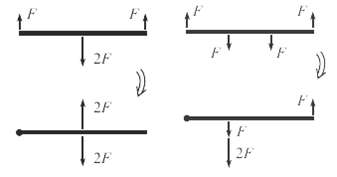This problem gives another way of demonstrating Claim 1.1, using an inductive argument. We'll get you started,
Question:
This problem gives another way of demonstrating Claim 1.1, using an inductive argument. We'll get you started, and then you can do the general case. Consider the situation where forces F are applied upward at the ends of a stick of length ?, and a force 2F is applied downward at the midpoint (see Fig.). The stick will not rotate (by symmetry), and it will not translate (because the net force is zero). If we wish, we may consider the stick to have a pivot at the left end. If we then erase the force F on the right end and replace it with a force 2F at the middle, then the two 2F forces in the middle will cancel, so the stick will remain at rest.7 Therefore, we see that a force F applied at a distance ? from a pivot is equivalent to a force 2F applied at a distance ?/2 from the pivot, in the sense that they both have the same effect in cancelling out the rotational effect of the downwards 2F force. Now consider the situation where forces F are applied upward at the ends, and forces F are applied downward at the ?/3 and 2?/3 marks (see Fig.). The stick will not rotate (by symmetry), and it will not translate (because the net force is zero). Consider the stick to have a pivot at the left end. From the above paragraph, the force F at 2?/3 is equivalent to a force 2F at ?/3. Making this replacement, we now have a total force of 3F at the ?/3 mark. Therefore, we see that a force F applied at a distance ? is equivalent to a force 3F applied at a distance ?/3. Your task is to now use induction to show that a force F applied at a distance ? is equivalent to a force nF applied at a distance ?/n, and to then argue why this demonstrates Claim 1.1.

Step by Step Answer:






